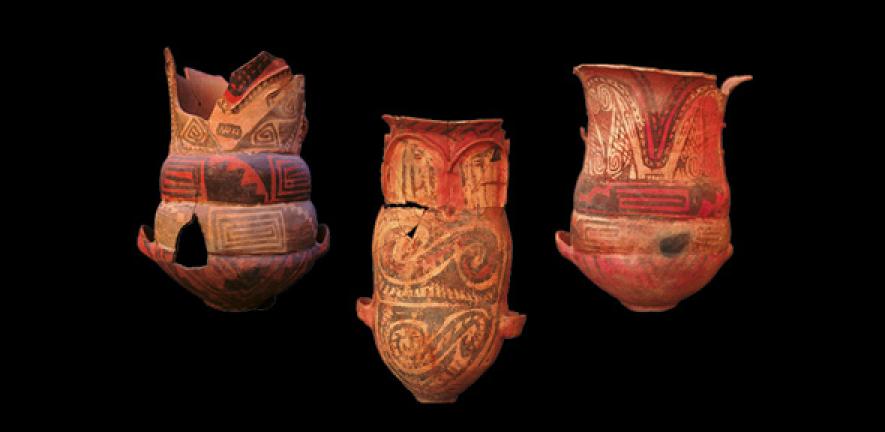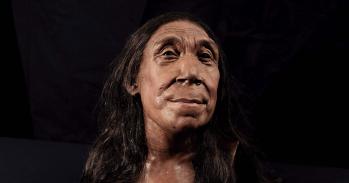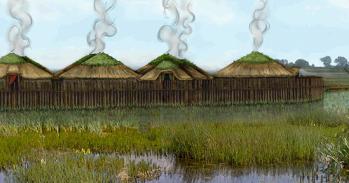
Objects unearthed in the Andes tell new stories of societies lacking hierarchical leadership in the time before the Inka Empire.
Objects unearthed in the Andes tell new stories of societies lacking hierarchical leadership in the time before the Inka Empire.
Distinctive clay urns with painted motifs showing serpents, frogs and birds, as well as human facial features, were found to contain the skeletal remains of young infants.
The town of Borgatta was built in the Argentinean Andes sometime in the tenth century. It grew to a community of several hundred residential compounds before being abandoned around 1450 when the Inkan Empire claimed the region. In the ruins, archaeologist Dr Elizabeth DeMarrais has been hunting for signs of pre-Inkan elites.
Her interests lie in the dynamics of social groups in the past – how did society work? Were there ‘pecking orders’ or hierarchies? When did the ‘politics’ of daily existence begin to characterise human societies, from the ancient to our own? The excavation of Borgatta, which she led, was to yield some surprising results.
“It’s a big site, with a population that would have numbered in the low thousands,” she explains. “We therefore expected to find evidence of leaders, of rich and poor – as in our own society. But we were surprised to see only limited social differentiation in the materials we uncovered.”
She studies the fragments – the archaeology of daily life – that societies left behind. “We thought we’d see socio-economic differences reflected in diet through remains of animal bones, or in dwelling locations, or in material accumulation,” she explains.
The team found evidence of craft production occurring across the entire settlement. But no specialists could be identified: no equivalent of a blacksmith’s workshop, or a dedicated weaver or a kiln technician. And no wealthy elites with stockpiles of luxury goods. Yet things were being made in most houses in town – things that defied easy classification.
“Think of the feather cloaks of Hawaiian chiefs, or the swords of Bronze Age warriors,” adds DeMarrais. “These were objects of wealth and power, commissioned from specialist technicians for elites who controlled production and often also trade. This commodification is typical in hierarchical societies.
“In Borgatta, however, we found evidence of nonspecialist ‘multicrafting’ right across the community: with each household using expedient bone and stone toolkits to create a range of objects – from baskets to cooking pots, spindle whorls to wooden bowls – in their own idiosyncratic styles.”
Each residence produced its own items. Household members shared skills and mixed media – creating distinctive artistry in the process.
“Archaeologists like to classify, and the diversity of the Borgatta materials was initially frustrating. However, ideas from social theory helped us think about the significance of this variation, including contexts of production and social roles,” says DeMarrais.
The approach to making things in Borgatta has led her to believe that its people depended upon “a different kind of social glue” – one based on individual relationships, rather than ordered by social rank.
“Objects were gifted on a personal basis to build connections, rather than being funnelled up to a leader who represented the group.” She describes this as a ‘heterarchy’: a society ordered along the lines of decentralised networks and shared power.
“Heterarchy was described in the 1940s as a means of understanding the structure of the human brain: ordered but not hierarchically organised. In a human society, it highlights a structure where different individuals may take precedence in key activities – religion, trade, politics – but there is a fluidity to power relations that resists top-down rule.
“One can think of it as a form of confederacy – similar in some respects to the governance of Cambridge colleges, for example,” says DeMarrais.
Artefacts tell the story of this laterally ordered society. Distinctive clay urns with painted motifs showing serpents, frogs and birds, as well as human facial features, were found to contain the skeletal remains of young infants.
The urns were buried under the floors of houses. DeMarrais suggests that the funeral rites of babies involved displaying urns in the community as part of an extended process of mourning, before they were returned to the residences.
Some urns had the rim extending above the floor, to allow ongoing access to the contents. “In the Andes, mortuary practices involved extended interaction with remains that sustained a sense of connection between the living and the dead.”
The decorated urns were the most striking pieces of material culture excavated at Borgatta. Adults were simply buried in groups of three or four outside the home, while other children were interred in old cooking pots called ‘ollas’.
Why were the burial vessels of certain infants so distinctive? “The emotions around such premature loss may have been intense. But emotion is also culturally constructed. Would our grief be the same as their grief?” asks DeMarrais.
“These urns may have been intended to evoke emotions. In the absence of centralised authority, we would expect that rituals involving display of objects and the inculcation of shared emotions were an important means of social cohesion.”
There is little standardisation of the urns. Borgatta artisans exercised considerable freedom, says DeMarrais, combining design elements in novel ways. “Each urn, with its individual qualities, may have referenced the unique infant interred inside. But the diversity of motifs also reflects the localised character of social ties within a heterarchical society.”
The shape of some painted urn motifs hinted at design constraints faced by weavers, supporting the ‘multi-crafters’ idea. “We think this similarity suggests that patterns first appeared on textile, and were then transferred to the urns by individuals with experience in both crafts.”
As an archaeologist you have to accept you will never have the definitive answers. We work with fragments.
Elizabeth DeMarrais
The things observed in Borgatta suggest the lives of artisans in this heterarchy were more varied and creative, given the diversity of social roles objects had to play. The things of the Inka Empire, however, were made by specialist artisans whose skill level was high, but who were tightly constrained by the state in their artistic expression.
Neither society had a writing system, so material culture was vital for communication. And for the Inkas, a central aim was expressing power through an identifiable ‘brand’.
“The Inkas had rules about who could wear and own what, according to status. Inka objects and architecture were immediately recognisable – like a Coca-Cola bottle in our world. This is, in part, how the Inkas managed to integrate roughly 12 million people across 80 ethnic groups without a writing system.”
Whereas Inkans had specialists who worked to formulae, each object made in Borgatta may well have had numerous ‘authors’ through multicrafting in household workshops. DeMarrais envisions a workshop environment similar to a tech start-up’s open-plan office: “people with different skill-sets pitch ideas and collaborate to create new products to adapt to a changing world”.
The Department of Archaeology’s Material Culture Laboratory, which DeMarrais runs with her colleague Professor John Robb, takes a ‘Borgattan approach’. Researchers working on artefacts from Ancient Egypt to Anglo-Saxon England come together to conduct comparative analyses, and debate how ‘things’ mediated social relations in the past.
“We ask why humans put their energy into particular objects,” explains DeMarrais. “We look for commonalities – from religion to bureaucracies – as well as differences. We ask what happens when you look at an object through a different theoretical lens, whether economic, political, ideological or ontological.”
“What you find – as Elizabeth’s work shows beautifully – is that social life works materially,” says Robb. “Whether it is a government trying to exert its authority, villagers organising their lives to meet their own needs, or individuals remembering and feeling emotions about their own history, things are the medium of the whole process.”
“In the end,” adds DeMarrais, “it’s about squeezing as much information as we can from things people have left behind to build a picture of human lives across time. As an archaeologist you have to accept you will never have the definitive answers. We work with fragments.”

The text in this work is licensed under a Creative Commons Attribution 4.0 International License. For image use please see separate credits above.




